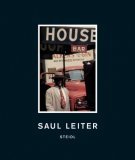Saul Leiter started shooting color and black-and-white street photography in New York in the 1940s. He had no formal training in photography, but the genius of his early work was quickly acknowledged by Edward Steichen, who included Leiter in two important MoMA shows in the 1950s. MoMA’s 1957 conference “Experimental Photography in Color” featured 20 color photographs by Leiter.
After that, however, Leiter’s personal color photography was, for the most part, not shared with the public. He became better-known as a successful fashion photographer in the 1950s and 60s. All the while, Leiter continued to stroll the streets wherever he was (mostly New York and Paris), making photographs for his own pleasure. He printed some of his black-and-white street photos, but kept most of his color slides tucked away in boxes. It was only in the 1990s that he began to look back at that remarkable color work and start to make prints. His sense of color and densely compressed urban life represents a truly unique vision of those times.
The first European retrospective of Saul Leiter’s street photography took place at the Fondation Henri Cartier-Bresson in Paris. The exhibition included one floor of black-and-white images, and another floor of all color. The color work is especially thrilling to see because not much of it had been seen before—and it is all wonderful and quirky and surprisingly fresh. A book just published by Steidl coincides with this retrospective, and includes more than 100 black-and-white and color photographs.
Leiter, who is 84 and still quite active, came to Paris for the opening of his show. He is humble and unassuming and intensely curious about things around him. In an interview for the new book, he said:
“I started out as a fashion photographer. One cannot say that I was successful but there was enough work to keep me busy. I collaborated with Harper’s Bazaar and other magazines. I had work and I made a living. At the same time, I took my own photographs.
“I spent a great deal of my life being ignored. I was always very happy that way. Being ignored is a great privilege. That is how I think I learnt to see what others do not see and to react to situations differently. I simply looked at the world, not really prepared for anything.”
At the exhibition press conference held in Paris, Leiter confided that he often purchased inexpensive color film that was past its expiration date: he loved to be surprised by the odd shifts in color that would result. He also told funny stories about Robert Frank and his friend Diane Arbus. “Robert complained to me one morning over breakfast at the L&M that he was going back to Switzerland because there was nothing interesting to photograph in America!” (at this point Leiter paused to laugh) “Then he went out and made The Americans!” Leiter also recounted how he turned down Steichen’s invitation to participate in the now-famous Family of Man exhibition: “It seemed to me that that exhibition was less about photography, and more about things that I wasn’t sure of.”
Art critic Roberta Smith wrote in 2005: “Mr. Leiter was a photographer less of people than of perception itself. His painter’s instincts served him well in his emphasis on surface, spatial ambiguity and a lush, carefully calibrated palette. But the abstract allure of his work doesn’t rely on soft focus, a persistent, often irritating photographic ploy, or the stark isolation of details, in the manner of Aaron Siskind or early Harry Callahan. Instead, Mr. Leiter captured the passing illusions of everyday life with a precision that might almost seem scientific, if it weren’t so poetically resonant and visually layered.”
The book by Steidl is stellar. It is beautifully printed and contains inspiring sequences of black-and-white and color photographs, some of which are shown for the first time. There’s a good interview with Leiter, too. Highly recommended.
—Jim Casper
Editors’ note: Saul Leiter passed away in November 2013 in New York City. His work continues to be shown in galleries and museums around the world and his work looks beautiful in book form. A feature-length documentary, titled “In No Great Hurry,” was produced with Leiter before his death and is an inspirational portrait of this pioneering photographer.
Saul Leiter: Photos
Hardcover, 144 pages
Steidl & Partners (March 1, 2008)
English or French
Buy on Amazon





